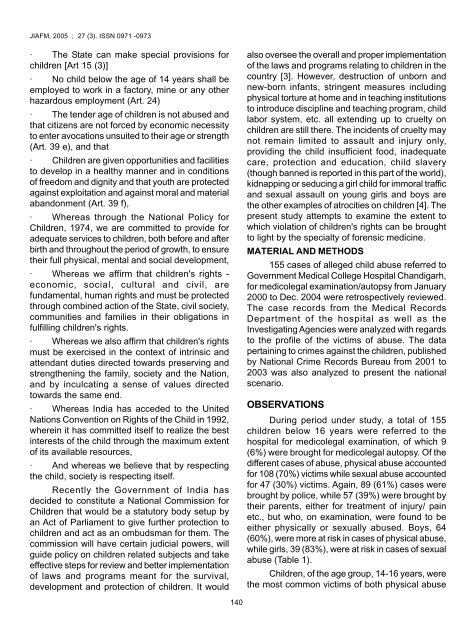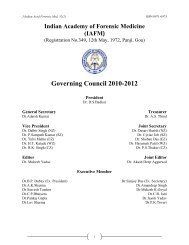violation of children's rights: can forensic medicine help?
violation of children's rights: can forensic medicine help?
violation of children's rights: can forensic medicine help?
Create successful ePaper yourself
Turn your PDF publications into a flip-book with our unique Google optimized e-Paper software.
JIAFM, 2005 ; 27 (3). ISSN 0971 -0973<br />
· The State <strong>can</strong> make special provisions for<br />
children [Art 15 (3)]<br />
· No child below the age <strong>of</strong> 14 years shall be<br />
employed to work in a factory, mine or any other<br />
hazardous employment (Art. 24)<br />
· The tender age <strong>of</strong> children is not abused and<br />
that citizens are not forced by economic necessity<br />
to enter avocations unsuited to their age or strength<br />
(Art. 39 e), and that<br />
· Children are given opportunities and facilities<br />
to develop in a healthy manner and in conditions<br />
<strong>of</strong> freedom and dignity and that youth are protected<br />
against exploitation and against moral and material<br />
abandonment (Art. 39 f),<br />
· Whereas through the National Policy for<br />
Children, 1974, we are committed to provide for<br />
adequate services to children, both before and after<br />
birth and throughout the period <strong>of</strong> growth, to ensure<br />
their full physical, mental and social development,<br />
· Whereas we affirm that <strong>children's</strong> <strong>rights</strong> -<br />
economic, social, cultural and civil, are<br />
fundamental, human <strong>rights</strong> and must be protected<br />
through combined action <strong>of</strong> the State, civil society,<br />
communities and families in their obligations in<br />
fulfilling <strong>children's</strong> <strong>rights</strong>.<br />
· Whereas we also affirm that <strong>children's</strong> <strong>rights</strong><br />
must be exercised in the context <strong>of</strong> intrinsic and<br />
attendant duties directed towards preserving and<br />
strengthening the family, society and the Nation,<br />
and by inculcating a sense <strong>of</strong> values directed<br />
towards the same end.<br />
· Whereas India has acceded to the United<br />
Nations Convention on Rights <strong>of</strong> the Child in 1992,<br />
wherein it has committed itself to realize the best<br />
interests <strong>of</strong> the child through the maximum extent<br />
<strong>of</strong> its available resources,<br />
· And whereas we believe that by respecting<br />
the child, society is respecting itself.<br />
Recently the Government <strong>of</strong> India has<br />
decided to constitute a National Commission for<br />
Children that would be a statutory body setup by<br />
an Act <strong>of</strong> Parliament to give further protection to<br />
children and act as an ombudsman for them. The<br />
commission will have certain judicial powers, will<br />
guide policy on children related subjects and take<br />
effective steps for review and better implementation<br />
<strong>of</strong> laws and programs meant for the survival,<br />
development and protection <strong>of</strong> children. It would<br />
also oversee the overall and proper implementation<br />
<strong>of</strong> the laws and programs relating to children in the<br />
country [3]. However, destruction <strong>of</strong> unborn and<br />
new-born infants, stringent measures including<br />
physical torture at home and in teaching institutions<br />
to introduce discipline and teaching program, child<br />
labor system, etc. all extending up to cruelty on<br />
children are still there. The incidents <strong>of</strong> cruelty may<br />
not remain limited to assault and injury only,<br />
providing the child insufficient food, inadequate<br />
care, protection and education, child slavery<br />
(though banned is reported in this part <strong>of</strong> the world),<br />
kidnapping or seducing a girl child for immoral traffic<br />
and sexual assault on young girls and boys are<br />
the other examples <strong>of</strong> atrocities on children [4]. The<br />
present study attempts to examine the extent to<br />
which <strong>violation</strong> <strong>of</strong> <strong>children's</strong> <strong>rights</strong> <strong>can</strong> be brought<br />
to light by the specialty <strong>of</strong> <strong>forensic</strong> <strong>medicine</strong>.<br />
MATERIAL AND METHODS<br />
155 cases <strong>of</strong> alleged child abuse referred to<br />
Government Medical College Hospital Chandigarh,<br />
for medicolegal examination/autopsy from January<br />
2000 to Dec. 2004 were retrospectively reviewed.<br />
The case records from the Medical Records<br />
Department <strong>of</strong> the hospital as well as the<br />
Investigating Agencies were analyzed with regards<br />
to the pr<strong>of</strong>ile <strong>of</strong> the victims <strong>of</strong> abuse. The data<br />
pertaining to crimes against the children, published<br />
by National Crime Records Bureau from 2001 to<br />
2003 was also analyzed to present the national<br />
scenario.<br />
OBSERVATIONS<br />
During period under study, a total <strong>of</strong> 155<br />
children below 16 years were referred to the<br />
hospital for medicolegal examination, <strong>of</strong> which 9<br />
(6%) were brought for medicolegal autopsy. Of the<br />
different cases <strong>of</strong> abuse, physical abuse accounted<br />
for 108 (70%) victims while sexual abuse accounted<br />
for 47 (30%) victims. Again, 89 (61%) cases were<br />
brought by police, while 57 (39%) were brought by<br />
their parents, either for treatment <strong>of</strong> injury/ pain<br />
etc., but who, on examination, were found to be<br />
either physically or sexually abused. Boys, 64<br />
(60%), were more at risk in cases <strong>of</strong> physical abuse,<br />
while girls, 39 (83%), were at risk in cases <strong>of</strong> sexual<br />
abuse (Table 1).<br />
Children, <strong>of</strong> the age group, 14-16 years, were<br />
the most common victims <strong>of</strong> both physical abuse<br />
140




![syllabus in forensic medicine for m.b.b.s. students in india [pdf]](https://img.yumpu.com/48405011/1/190x245/syllabus-in-forensic-medicine-for-mbbs-students-in-india-pdf.jpg?quality=85)



![SPOTTING IN FORENSIC MEDICINE [pdf]](https://img.yumpu.com/45856557/1/190x245/spotting-in-forensic-medicine-pdf.jpg?quality=85)

![JAFM-33-2, April-June, 2011 [PDF] - forensic medicine](https://img.yumpu.com/43461356/1/190x245/jafm-33-2-april-june-2011-pdf-forensic-medicine.jpg?quality=85)


![JIAFM-33-4, October-December, 2011 [PDF] - forensic medicine](https://img.yumpu.com/31013278/1/190x245/jiafm-33-4-october-december-2011-pdf-forensic-medicine.jpg?quality=85)


